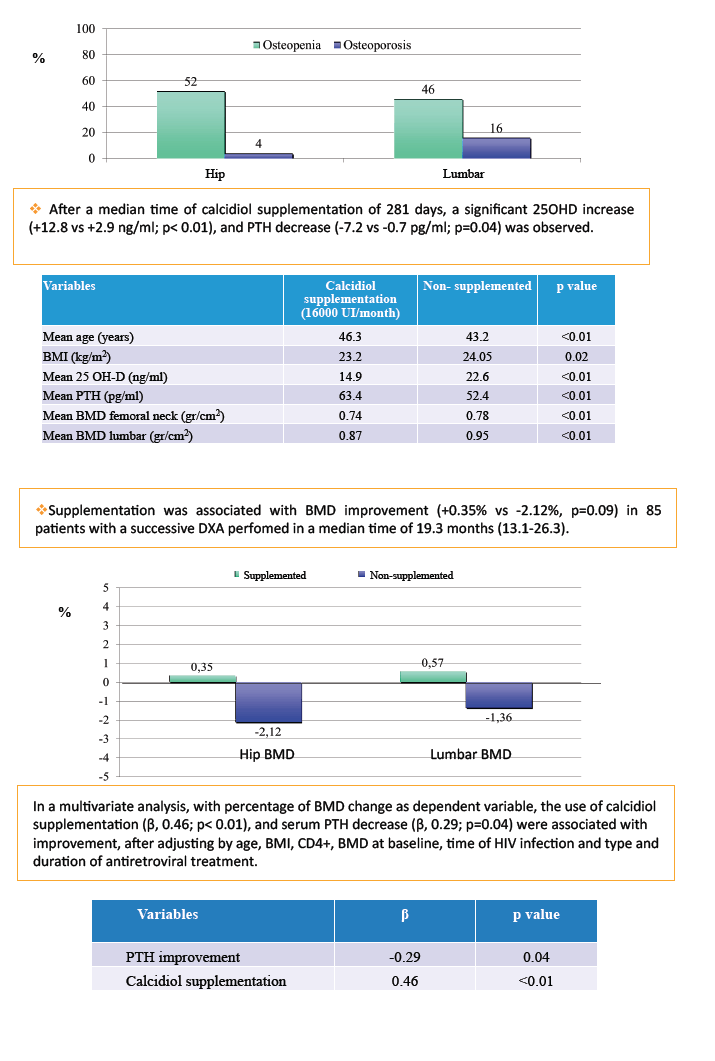 |
 |
 |
| |
Effect of monthly calcidiol supplementation on secondary hyperparathyroidism and bone mineral density in HIV-infected patients with vitamin D deficiency
|
| |
| |
Reported by Jules Levin
20th International AIDS Conference, July 20-25, 2014, Melbourne
S. Banon, J.L. Casado, A. Diaz de Santiago, A. Moreno, M.J. Perez-Elias, S. Moreno
Ramon y Cajal Hospital, Infectious Diseases, Madrid, Spain

Program Abstract
Background: To determine vitamin D deficiency effect on bone mineral density (BMD) in HIV patients and the response to supplementation with calcidiol.
Methods: Observational study of 411 VIH patients with at least two sequential determinations of vitamin D (25OH-D), and parathyroid hormone (PTH). All patients had a bone densitometry (DXA) performed at the same time. Secondary hyperparathyroidism (SHP) was defined when PTH >65 pg/ml. Overall, 97 patients received oral calcidiol supplementation (16000 IU monthly).
Results: Mean age was 44.6 years, 75% were male, and 158 (38%) had HCV co-infection. Mean body mass index (BMI) was 23.9 Kg/m2. All patients were on ART (75% tenofovir, 33% efavirenz) for a mean time of 31 months (14.4-45.3) before evaluation. Mean serum 25OH-D was 20.2 ng/ml (1.8-59.7), with 13% of patients < 10 ng/ml, 57% < 20 ng/ml, and 85% < 30 ng/ml. Mean basal PTH was 55.2 (8-144) and 25% had a diagnosis of SHP. At this moment, prevalence of hip osteoporosis/osteopenia was 4/52%, whereas it was 16/46% in lumbar spine, respectively. There was no relation between 25OH-D serum levels and reduced BMD, but a lower hip T score was associated with SHP (-1.18 vs -0.92, p=0.03). Indeed, in a multivariate lineal regression analysis, older age, (ß, -0.3), BMI (ß, 0.25) and time of HIV infection (ß,-0.25) were associated with lower BMD. After a median time of calcidiol supplementation of 281 days, a significant 25OHD increase
(+12.8 vs +2.9 ng/ml; p< 0.01), and PTH decrease (-7.2 vs -0.7 pg/ml; p=0.04) was observed. Supplementation was associated with BMD improvement (+0.35% vs -2.12%, p=0.09) in 85 patients with a successive DXA perfomed in a median time of 19.3 months (13.1-26.3). In a multivariate analysis, with percentage of change as dependent variable, the use of calcidiol supplementation
(ß, 0.46; p< 0.01), and serum PTH decrease (ß, 0.29; p=0.04) were associated with improvement, after adjusting by age, BMI, CD4+, BMD at baseline, time of HIV infection and type and duration of antiretroviral treatment.
Conclusions: Oral supplementation with calcidiol improves BMD evolution in HIV patients, partly explain through the effect on PTH levels.


|
| |
|
 |
 |
|
|